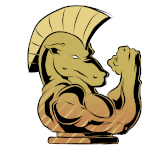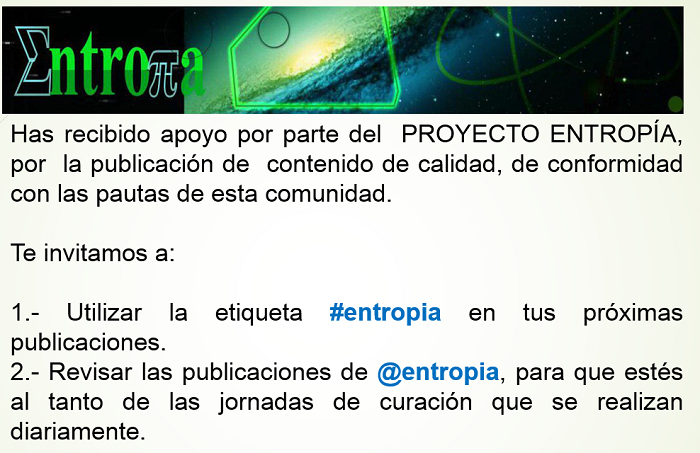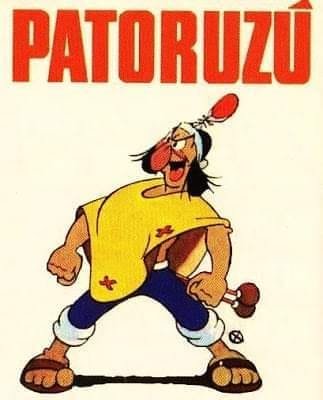
Exactamente un mes después del nacimiento de mi padre, en un exitoso periódico argentino de la época llamado Crítica, aparecía por primera vez una historieta cuyo personaje central era un cacique tehuelche de nombre Patoruzú, una creación que recién varios años después y gracias a diversas adaptaciones y algunos viajes por los Estados Unidos para aprender sobre dibujo, guiones y el negocio del comic, logró publicar y distribuir su propia revista, por supuesto con el nombre del famoso cacique. El autor y editor era Dante Quinterno.
En la tira además de Patoruzú aparece la Chacha, ama de crianza del tehuelche, un poco bruja y gran cocinera de empanadas, Isidoro Cañones el amigo porteño, con modales de adinerado sin un peso que encarnaba la más pura y casta viveza criolla y otros personajes que daban el exacto marco a una gran cantidad de correrías del bonachón y recto indio de las pampas. No podía faltar el caballo de Patoruzú, se llamaba Pampero y era otro héroe del comic.
Para el año 1945 salió a la venta por primera vez la revista Patoruzito, la versión juvenil de Patoruzú, pensada para niños y con los mismos personajes ambientada en una época anterior, cuando eran jóvenes; como su predecesora, otro gran éxito que hacía el deleite de todos, estaban los adultos que compraban la revista de Patoruzú y luego para sus hijos y sobrinos Patoruzito aunque terminaban leyendo ambas.
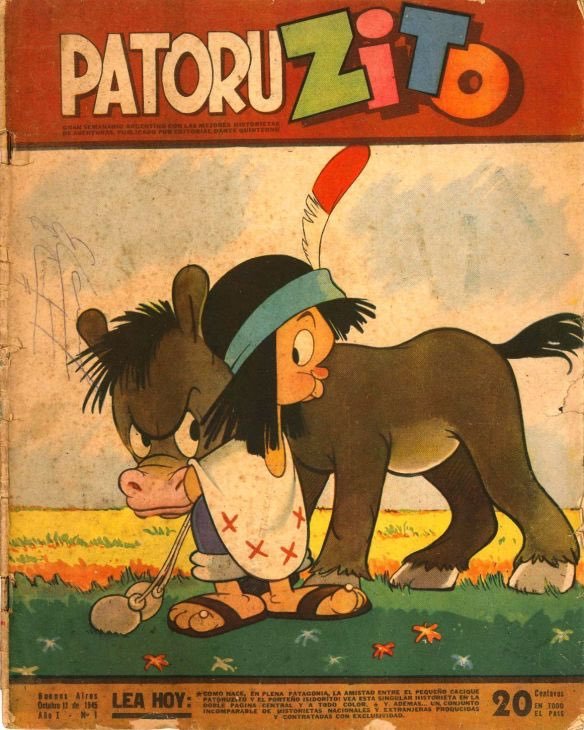
En esas revistas había publicidades, en la contratapa y en ocasiones también entre las páginas de la historieta; recuerdo una en particular, la de Charles Atlas, un hombre con grandes músculos y poses ideadas para resaltar su físico privilegiado. Una cosa llamaba mi atención, tanto que todavía la recuerdo. Siempre la publicidad comenzaba diciendo que había sido un alfeñique de 44 kilos que gracias a su método de ejercitación se había convertido en el hombre con el mejor cuerpo en todo el planeta. La publicidad apuntaba a vender un tipo de método a seguir para lograr un físico como el del señor Atlas.
Con el tiempo descubrí algunos datos interesantes sobre Charles Atlas en una revista que por estos lares fue muy popular en mis años mozos, se llama Selecciones del Reader's Digest y posee un récord difícil de igualar, se editó por primera vez en 1922 y aún hoy continúa vigente. En aquel tiempo, en la revista había un poco de todo, principalmente notas de interés general, consejos sobre diferentes cuestiones y un resumen de libros e historias de época.

En una de sus ediciones fue que leí la historia de Angelo Siciliano, un calabrés nacido un 30 de octubre de 1892 que debió dejar su tierra de origen para emigran junto a su familia a los Estados Unidos de Norteamérica allá por 1904, tenía un físico esmirriado que lo llevó a ser burlado por sus compañeros de colegio en esa dura infancia y juventud marcada por el desarraigo.
Un día, Angelo vio una estatua de Hércules mientras recorría el museo de Brooklyn, en ese momento nació en El un ferviente deseo de transformar su físico para ser igual al del héroe mitológico inmortalizado en piedra. Así fue como se inscribió en un gimnasio de la YMCA y comenzó su increíble transformación. La frase que veía habitualmente en la revista Patoruzito sobre el alfeñique de 44 kilos terminó siendo una historia real de una persona de carne y hueso.
En 1921 la revista Physical Culture organizó un concurso de fisicoculturismo nada menos que en el mítico Madison Square Garden de Nueva York y el ex niño flacucho y débil que había sido víctima de bulling por sus compañeros de colegio, fue proclamado como “el hombre más perfectamente desarrollado del mundo".
Para acrecentar su fama, Angelo Siciliano ideó su propio método de entrenamiento al que llamó "tensión dinámica", consistía básicamente en confrontar la fuerza de un músculo contra otro sin el uso de máquinas u otros elementos externos. Fue un éxito mundial que lo convirtió en millonario.
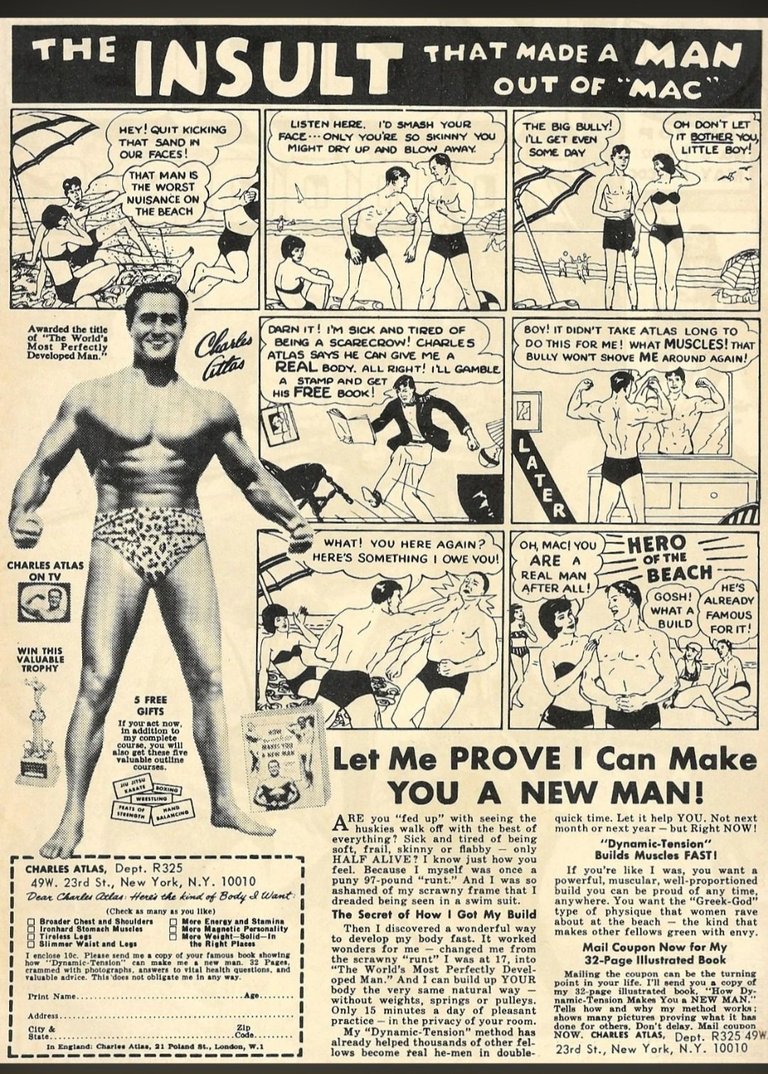
Más tarde me enteré que Buenos Aires fue la única cuidad de Latinoamérica en tener una sede de Charles Atlas, apelativo que adoptó para comercializar su método de entrenamiento.
El 30 de octubre de cada año se celebra el día del fisicoculturista en homenaje a la fecha de nacimiento del primer cultor e impulsor del entrenamiento para mejorar el cuerpo, un tal Angelo Siciliano o Charles Atlas si lo prefieren.
Bodybuilder's Day
Exactly one month after my father was born, a successful Argentine newspaper of the time called Crítica published for the first time a comic strip with a central character, a Tehuelche chief named Patoruzú. It was only several years later, thanks to various adaptations and some trips to the United States to learn about drawing, scripts, and the comics business, that he managed to publish and distribute his magazine, of course with the name of the famous chief. The author and editor was Dante Quinterno.
In addition to Patoruzú, the strip also features Chacha, the Tehuelche's foster mother, a bit of a witch and a great empanada cook, Isidoro Cañones, the friend from Buenos Aires, with the manners of a wealthy man without a penny who embodied the purest and most chaste Creole liveliness, and other characters that provided the exact framework for a large number of escapades of the good-natured and upright Indian from the pampas. Patoruzú's horse could not be missing, it was called Pampero, another comic hero.
In 1945, the magazine Patoruzito, the youth version of Patoruzú, was released for the first time. It was designed for children and had the same characters set earlier when they were young. Like its predecessor, another great success that delighted everyone, some adults bought the Patoruzú magazine and then Patoruzito for their children and nephews, although they ended up reading both.
In these magazines there were advertisements, on the back cover and sometimes also between the pages of the comic strip; I remember one in particular, that of Charles Atlas, a man with big muscles and poses designed to highlight his privileged physique. One thing caught my attention, so much that I still remember it. The advertisement always began by saying that he had been a 44-kilo weakling who, thanks to his exercise method, had become the man with the best body on the planet. The advertisement aimed to sell a type of method to follow to achieve a physique like Mr. Atlas's.
Over time, I discovered some interesting facts about Charles Atlas in a magazine that was very popular in these parts of my youth, called Reader's Digest Selections, and it has a record that is hard to match: it was first published in 1922 and is still in print today. At that time, the magazine contained a bit of everything, mainly general interest articles, advice on different issues, and a summary of books and period stories.
In one of its editions, I read the story of Angelo Siciliano, a Calabrian born on October 30, 1892, who had to leave his homeland to emigrate with his family to the United States of America back in 1904. He had a puny physique that led him to be mocked by his schoolmates in that hard childhood and youth marked by uprooting.
One day, Angelo saw a statue of Hercules while touring the Brooklyn Museum, and at that moment a fervent desire was born in him to transform his physique to be like that of the mythological hero immortalized in stone. That's how he enrolled in a YMCA gym and began his incredible transformation. The phrase that he regularly saw in Patoruzito magazine about the 44-kilo weakling ended up being a real story of a real person.
In 1921, Physical Culture magazine organized a bodybuilding contest in none other than the legendary Madison Square Garden in New York, and the former skinny and weak boy who had been bullied by his schoolmates was proclaimed as “the most perfectly developed man in the world.”
To increase his fame, Angelo Siciliano devised his training method, which he called “dynamic tension.” It consisted of confronting the strength of one muscle against another without the use of machines or other external elements. It was a worldwide success that made him a millionaire.
Later, I learned that Buenos Aires was the only city in Latin America to have a Charles Atlas headquarters, a nickname he adopted to market his training method.
Every year, October 30th is celebrated as Bodybuilder's Day in honor of the birth date of the first bodybuilder and promoter of training to improve the body, a certain Angelo Siciliano or Charles Atlas if you prefer.
Héctor Gugliermo
@hosgug
